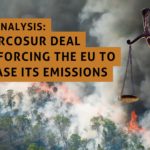Last week, EU leaders sent a clear message to the European Commission to ramp up its work to implement the Paris Agreement and accelerate the ongoing transition away from fossil fuels, writes Wendel Trio.
Wendel Trio is Director of Climate Action Network (CAN) Europe, a campaign group.
Originally published by EURACTIV on 29 March 2018.
Leaders called upon the Commission to develop a long-term climate strategy which will translate the objectives of the Paris Agreement into action. They want the first draft by early 2019, so that the strategy can be finalised by 2020, as agreed in Paris in December 2015.
By doing so, Europe’s Heads of State and Government have started the process of reviewing the EU’s current climate commitments. This opens up the long-delayed but much-needed discussion on how to ensure the EU’s plans to cut carbon emissions are coherent with the Paris Agreement.
The decision fits perfectly with the so-called Talanoa Dialogue, the Fijian name for an exercise under the Paris Agreement happening this year. This process was established to look at how countries can move from the currently inadequate levels of action towards the efforts needed to keep temperature rise well below 2°C and preferably even at 1.5°C.
To be Paris-compatible, the EU’s strategy must clearly lay out pathways for how the bloc will contribute to efforts to keep limit temperature rise to 1.5°C. It will need to set out how to scale up climate action from incremental to transformational. It will also need to set milestones for what needs to be achieved by 2030, and every five years thereafter.
Based on these premises, the strategy will prove beyond doubt that the current climate target of reducing emission by at least 40% by 2030 is woefully inadequate.
A recent study by the Oeko Institute clearly shows that for the EU to contribute its fair share to keeping global temperature rise to 2 degrees, it would have to set itself an emission reduction target of 55% for 2030. To limit temperature rise to 1.5 degrees, we should be looking at a target in the range of -65%.
A whole set of new legislation on future climate and energy policies has already been agreed or is in the process of being agreed. Negotiations on the ‘Clean Energy Package’, including targets for renewable energy and energy efficiency are going into the last phase and are expected to conclude by summer this year.
Even if during the negotiations with member states, the European Parliament manages to secure a greater share of renewable energy and more energy efficient economies by 2030, it would still deliver only the bare minimum of the emission reductions needed to match the challenge ahead.
But in fact, the discussion on the level of ambition does not end there.
The European Parliament has opened the doors for higher ambition by calling for the EU’s long term strategy to deliver net zero emissions by 2050 at the latest.
In Paris, world leaders, including European ones, have also agreed that every five years all countries will revisit and increase their ambition. A critical milestone lies ahead of us: by 2020 the EU will need to resubmit its 2030 target to the United Nations Convention on Climate Change.
This resubmission will have to take into account the new long term strategy, which, thanks to the pressure from EU leaders, will certainly have to be ready by then. Therefore, it is this new strategy that can facilitate a revision and an increase of the targets.
It is time for the European Commission to listen up. It is time for real leadership and urgent action, building on the clear momentum for the transition we are already seeing in our societies and economies.
This is a critical moment to deliver a clear vision on how to accelerate the Union’s transition to a fully renewable, energy efficient economy, free from polluting fossil fuel emissions. It is also a great opportunity to redo the maths and propose targets that match up to the urgency of the climate crisis. There is no time to lose.


